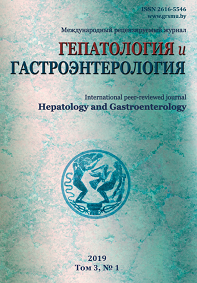ГИСТОФИЗИОЛОГИЯ ДУКТАЛЬНОЙ СЕКРЕЦИИ ПОДЖЕЛУДОЧНОЙ ЖЕЛЕЗЫ
Аннотация
В обзоре представлены современные литературные сведения о гистофизиологии дуктальной секреции поджелудочной железы. Рассмотрены особенности строения и функции разных отделов протоковой системы. Обсуждены механизмы секреции дуктулоцитами электролитов и воды в состав поджелудочного сока. Показана роль ионных каналов и белков-переносчиков в транспортных процессах через базолатеральную и апикальную мембраны протоковых клеток.Литература
1. Shubnikova EA. Podzheludochnaja zheleza: svjaz anatomii, fiziologii i patologii [Pancreas: the connection of anatomy, physiology and pathology]. Moskva: Izdatelstvo MGU; 1996. 256 p. (Russian).
2. Argent BE, Arkle S, Cullen MJ, Green R. Morphological, biochemical and secretory studies on rat pancreatic ducts maintained in tissue culture. Q. J. Exp. Physiol. 1986;71(4):633-648.
3. Ishiguro H, Yamamoto A, Nakakuki M, Yi L, Ishiguro M, Yamaguchi M, Kondo S, Mochimaru Y. Physiology and pathophysiology of bicarbonate secretion by pancreatic duct epithelium. Nagoya J. Med. Sci. 2012;74(1-2):1-18.
4. Steward MC, Ishiguro H, Case RM. Mechanisms of bicarbonate secretion in the pancreatic duct. Annu Rev. Physiol. 2005;67:377-409.
5. Maev IV, Kucherjavyj JuA. Bolezni podzheludochnoj zhelezy [Diseases of pancreas]. Moskva: Medicina; 2008. 558 p. (Russian).
6. Ohana E, Yang D, Shcheynikov N, Muallem S. Diverse transport modes by the solute carrier 26 family of anion transporters. J. Physiol. 2009;587(Pt 10):2179-2185. doi: 10.1113/jphysiol.2008.164863.
7. Wilschanski M, Novak I. The cystic fibrosis of exocrine pancreas. Cold Spring Harb. Perspect. Med. 2013;3(5):a009746. doi: 10.1101/cshperspect.a009746.
8. Pallagi P, Hegyi P, Rakonczay ZJr. The Physiology and Pathophysiology of Pancreatic Ductal Secretion: The Background for Clinicians. Pancreas. 2015;44(8):1211-1233. doi: 10.1097/MPA.0000000000000421.
9. Korotko GF. Sekrecija podzheludochnoj zhelezy [Secretionof the pancreas]. 2nd ed. Krasnodar: Izdatelstvo KGMU; 2005. 312 p. (Russian).
10. Case RM, Argent BE. Pancreatic duct cell secretion: control and mechanisms of transport. In: VLW Go, Dimagno EP, Gardner JD, Lebenthal E, Reber HA, Scheele GA, editors. The Pancreas: Biology, Pathobiology and Disease. 2nd ed. New York: Raven Press; 1993. p. 301-350.
11. Burghardt B, Nielsen S, Steward MC. The role of aquaporin water channels in fluid secretion by the exocrine pancreas. J. Membr. Biol. 2006;210(2):143-153. doi: 10.1007/s00232-005-0852-6.
12. Burghardt B, Elkaer ML, Kwon TH, Rбcz GZ, Varga G, Steward MC, Nielsen S. Distribution of aquaporin water channels AQP1 and AQP5 in the ductal system of the human pancreas. Gut. 2003;52(7):1008-1016.
13. Lightwood R, Reber HA. Micropuncture study of pancreatic secretion in the cat. Gastroenterology. 1977;72(1):61-66.
14. Lojt AA, Zvonarev EG. Podzheludochnaja zheleza: svjaz anatomii, fiziologii i patologii [Pancreas: link of anatomy, physiology and pathology]. Voprosy rekonstruktivnoj i plasticheskoj hirurgii. 2013;16(3):48-53. (Russian).
15. Korotko GF. Sekrecija podzheludochnoj zhelezy: ot pavlovskih nachal k nastojashhemu [Secretion of the pancreas: from the Pavlov’s elements to the present time]. Rossijskij zhurnal gastrojenterologii, gepatologii, koloproktologii. 2014;(3):4-12. (Russian).
16. Voskanjan SJe. Morfofunkcionalnaja organizacija podzheludochnoj zhelezy i kliniko-jeksperimentalnye aspekty ostrogo posleoperacionnogo pankreatita [Morphofunctional organization of the pancreas and clinical and experimental aspects of acute postoperative pancreatitis] [masters thesis]. Moskva: Institut hirurgii imeni A.V. Vishnevskogo; 2013. 48 p. (Russian).
17. Korotko GF, Voskanjan SJe. Morfofunkcionalnaja organizacija sekretornoj dejatelnosti podzheludochnoj zhelezy (novaja paradigma) [Morphofunctional organization of secretory activity of the pancreas (new paradigm)]. Jeksperimentalnaja i klinicheskaja gastrojenterologija. 2003;3:43-46. (Russian).
18. Korotko GF, Voskanjan SJe. Reguljatornye kontury korrekcii sekrecii podzheludochnoj zhelezy [The regulatory contours of the pancreatic secretion]. Uspehi fiziologicheskih nauk. 2005;36(3):45-55. (Russian).
19. Schaffalitzky de Muckadell OB, Fahrenkrug J, Watt-Boolsen S, Worning H. Pancreatic response and plasma secretin concentration during infusion of low dose secretin in man. Scand. J. Gastroenterol. 1978;13(3):305-311.
20. Muallem S, Loessberg PA. Intracellular pH-regulatory mechanisms in pancreatic acinar cells. I. Characterization of H+ and HCO3 − transporters. J. Biol. Chem. 1990;265(22):12806-12812.
21. Park HW, Nam JH, Kim JY, Namkung W, Yoon JS, Lee JS, Kim KS, Venglovecz V, Gray MA, Kim KH, Lee MG. Dynamic regulation of CFTR bicarbonate permeability by [Cl-]i and its role in pancreatic bicarbonate secretion. Gastroenterology. 2010;139(2):620-631. doi: 10.1053/j. gastro.2010.04.004.
22. Shcheynikov N, Wang Y, Park M, Ko SB, Dorwart M, Naruse S, Thomas PJ, Muallem S. Coupling modes and stoichiometry of Cl-/HCO3- exchange by slc26a3 and slc26a6. J. Gen. Physiol. 2006;127(5):511-524. doi: 10.1085/jgp.200509392.
23. Bruce JI, Shuttleworth TJ, Giovannucci DR, Yule DI. Phosphorylation of inositol 1,4,5-trisphosphate receptors in parotid acinar cells. A mechanism for the synergistic effects of cAMP on Ca 2+ signaling. J. Biol. Chem. 2002;277(2):1340-1348. doi: 10.1074/jbc.M106609200/
24. Gross E, Hawkins K, Abuladze N, Pushkin A, Cotton CU, Hopfer U, Kurtz I. The stoichiometry of the electrogenic sodium bicarbonate cotransporter NBC1 is cell-type dependent. J. Physiol. 2001;531(Pt 3):597-603.
25. Delpire E, Gagnon KB. SPAK and OSR1: STE20 kinases involved in the regulation of ion homoeostasis and volume control in mammalian cells. Biochem. J. 2008;409(2):321-331. doi: 10.1042/BJ20071324.
26. Fanjul M, Alvarez L, Salvador C, Gmyr V, Kerr-Conte J, Pattou F, Carter N, Hollande E. Evidence for a membrane carbonic anhydrase IV anchored by its C-terminal peptide in normal human pancreatic ductal cells. Histochem. Cell Biol. 2004;121(2):91-99. doi: 10.1007/s00418-003-0616-2.
27. Lee MG, Ohana E, Park HW, Yang D, Muallem S. Molecular mechanism of pancreatic and salivary gland fluid and HCO3 secretion. Physiol. 2012;92(1):39-74. doi: 10.1152/physrev.00011.2011.
28. Alper SL. Molecular physiology and genetics of Na+-independent SLC4 anion exchangers. J. Exp. Biol. 2009;212(Pt 11):1672-1683. doi: 10.1242/jeb.029454.
29. Ko SB, Zeng W, Dorwart MR, Luo X, Kim KH, Millen L, Goto H, Naruse S, Soyombo A, Thomas PJ, Muallem S. Gating of CFTR by the STAS domain of SLC26 transporters. Nat. Cell Biol. 2004;6(4):343-350. doi: 10.1038/ncb1115.
30. Agre P. Aquaporin water channels (Nobel lecture). Angew Chem. Int. Ed. Engl. 2004;43(33):4278-4290. doi: 10.1002/anie.200460804.
31. Kunzelmann K. CFTR: interacting with everything? News Physiol. Sci. 2001;16:167-170.
32. Guggino WB, Stanton BA. New insights into cystic fibrosis: molecular switches that regulate CFTR. Nat. Rev. Mol. Cell. Biol. 2006;7(6):426-436. doi: 10.1038/nrm1949.
33. Verkman AS. Novel roles of aquaporins revealed by phenotype analysis of knockout mice. Rev. Physiol. Biochem. Pharmacol. 2005;155:31-55. doi: 10.1007/s10254-005-0040-1
34. Delporte C. Aquaporins in salivary glands and pancreas. Biochim. Biophys. Acta. 2014;1840(5):1524-1532.
35. Burghardt B, Elkaer ML, Kwon TH, Racz GZ, Varga G, Steward MC, Nielsen S. Distribution of aquaporin water channels AQP1 and AQP5 in the ductal system of the human pancreas. Gut. 2003;52(7):1008-1016.


















2.png)






